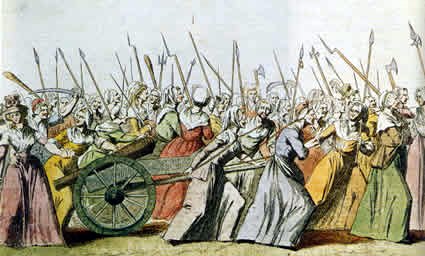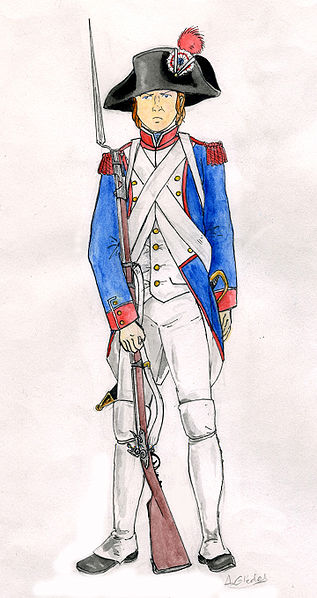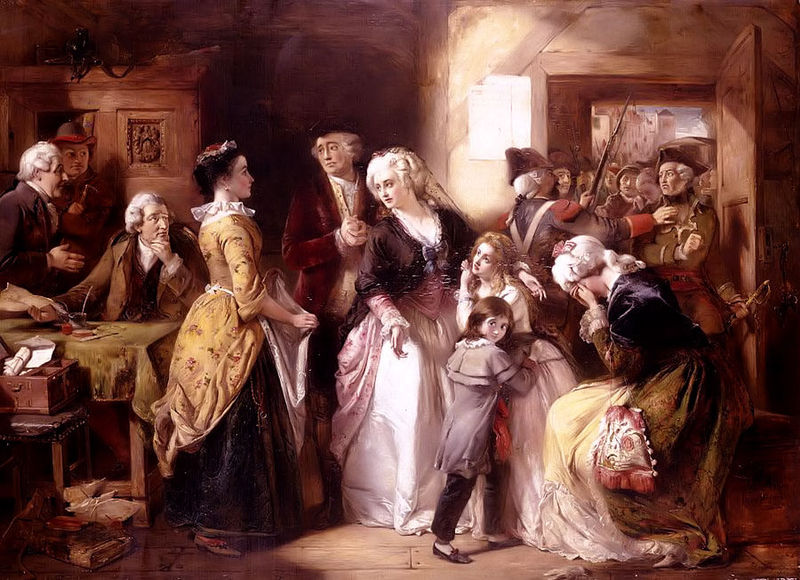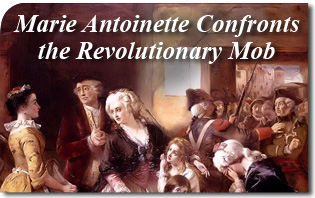by Imbert de Saint-Amand
Not everyone in Versailles enjoyed the truce during the nights of October 5th and 6th. Everything was at rest, except crime. The revolt had not yet completed its task and these demons, these disguised brigands who were shouting for bread when their pockets were full of gold, had not yet earned their pay. No, there was no sleep, for hate knows no fatigue for the furies who had sworn to cut off Marie Antoinette’s head on a milestone and to dip their hands in her blood.
Let us first note the insufficiency of La Fayette’s defensive measures and the absence of any excuse for his fatal confidence. During the whole of the 5th, the gateway of the Ministers’ Courtyard was precisely the point attacked by the populace who were furious to find this barrier. Who guarded this gate, which was of such importance for the defense of the palace? Two soldiers of the National Guard! Who protected the entrance of the marble staircase leading to the royal apartments? Two Swiss soldiers! Why was it that the royal battalions of the National Guard, which certainly contained trustworthy battle hardened men, were not ordered to defend the approaches to the palace?
Why was it that their commander, instead of going to rest in the rue de la Pompe, did not stay in the palace near his King at the post of duty and of honor? Without doubt, La Fayette was no traitor, but like men of his political complexion, he was absurdly optimistic and he did not dread the danger that was before his eyes. He lay down in good faith and when he awoke from his short sleep, he was overcome with surprise at events that anyone else would have foreseen.

At five thirty in the  morning, a great number of women suddenly made their appearance in the Place d’Armes. Many of them went up to the first gateway that led to the Ministers’ Courtyard, and the two National Guards who were stationed there opened the gate. Men armed with
morning, a great number of women suddenly made their appearance in the Place d’Armes. Many of them went up to the first gateway that led to the Ministers’ Courtyard, and the two National Guards who were stationed there opened the gate. Men armed with
pikes immediately followed and the courtyard was filled. The crowd saw that the gate of the Princes’ Courtyard, which was the one leading to the middle of the palace, where the royal princes dwelt, was open, and the populace hastened thither and entered the courtyard by a door at the foot of the princes’ staircase. At that moment Marie Antoinette was awakened by the noise beneath her windows. She rang for Madame Thibaut, and asked the meaning of this tumult. Madame Thibaut replied that it was the women from Paris, who, probably not being able to find any quarters, were walking on the terrace. She then withdrew, and the Queen, satisfied, remained in bed.
The Royal Court was still secure. The mayor of the bodyguard, M. d’Aguesseau, had just placed many guards in the passage of the colonnade leading from the Princes’ Courtyard to the Royal Courtyard. Those soldiers were too few to mount sufficient resistance and a wave of rioters drove them back. The Royal Courtyard was invaded, one of the bodyguards named Deshuttes was disarmed in front of the gateway, struck down and dragged dying to the end of the Ministers’ Courtyard. A rag picker named Jourdan placed his foot on Deshuttes’ chest, and cut his head off with an axe. His head was stuck on the point of a pike and paraded through the streets as a trophy of the insurrection and the victim’s body was carried to the barracks of the French Guard and thrown on a pile of straw.
Simultaneously, the crowd made a violent attack on the marble staircase, which is near the Marble Courtyard that led to the apartments of the King and Queen.

The marble staircase was defended by only two of the Hundred Swiss guards. The crowd mounted the staircase and the door between the marble staircase and the hall of the Queen’s Guards was burst open, and the rioters rushed in calling for the death of Marie Antoinette. One of the guards on duty, M. de Varicourt, was serving as sentinel before the door of the first ante-chamber, was struck from behind and fell bleeding. The crowd seized him, dragged him down the staircase and through the Princes’ Gate into the Ministers’ Courtyard. He was still alive and struggling with his assassins when Jourdan, the rag picker, ran up with his axe still dripping with the blood of M. Deshuttes, and cut his head off.
Meanwhile Madame Thibaut had gotten the Queen up and hurried her into her stockings and petticoat and threw a cloak over her shoulders.
After a few moments’ sleep, La Fayette woke up in the Noailles mansion, and it could be said that, “he slept just long enough to ruin the King.” He did not wait for a horse to be brought but started at once for the palace on foot and began to encourage his men to quell the disorder. Louis XVI himself thanked the members of the National Guard who had saved the lives of his bodyguards and with a noble calm and self-control, he called the ministers together in the Council Hall. The Queen, the Dauphin, Madame Royale, Madame Elisabeth, the Count of Provence and the aunts were all collected in the King’s bedroom. The Dauphin said to his mother, “Mamma, I’m hungry.” “Be patient” answered Marie Antoinette, “this will soon be over.”
The palace courtyards were filled with battalions of the National Guard and with the populace. Marie Antoinette stood perfectly calm at a window looking out on the vast throng. While everyone about her was giving way to tears and despair, she did not lose her head for a moment, but consoled and encouraged everyone.
Louis XVI went out on the balcony with the same air of confidence and kindness that he had always shown. Cries of “The Queen, the Queen!” were heard. La Fayette advised Marie Antoinette to show herself; he said it was the only way to allay the excitement. “Very well,” answered the Queen, “if I have to go to my execution, I shall not hesitate; I will go.” What was to take place? What was to be expected of these men, drunk and wild with wrath, uttering angry cries and carrying loaded muskets? Would the assassins of the bodyguard hesitate to murder a woman, their queen? It was a solemn moment. Marie Antoinette was pale and with disheveled hair when she appeared at the balcony of the King’s room accompanied by La Fayette, holding the Dauphin with one hand and her daughter with the other. The cries redoubled with shouts of “No children! No children! The Queen alone!” arose from all sides. What did this uproar mean? Did the demons that filled the place fear that the sight of the children would touch their hearts? Did the murderers who would gladly have slain the Mother hesitate about killing a boy and a girl? Without thinking about the probable evil significance of these shouts, Marie Antoinette gave the Dauphin and his sister to their father and then came out alone, fearless, heroic and calmly letting her eyes gaze upon the multitude with her arms folded.
It was the daughter of the Caesars who appeared. The noble haughtiness of her brow, the dignity of her bearing that wrung from the crowd a shout of admiration and surprise. Even those who a moment before wanted to kill her, joined in the cry. A loud roar of “Long live the Queen!” burst forth. Marie Antoinette was not duped by this greeting because she heard the crowd shouting another alarming cry: “To Paris with the King!” and, leaving the balcony, she went up to Madame Necker and said sadly, “They are going to make the King and me go to Paris with the heads of our guards carried before us on the ends of their pikes.”
Louis XVI, always weakly good-natured, decided to obey this insolent demand of the populace.
The preceding text is adapted from Marie Antoinette and the End of the Old Régime, a book by Imbert de Saint-Amand, trans. Thomas Sergeant Perry (New York: Charles Scribner’s Sons, 1914),pp. 258-267



No comments:
Post a Comment